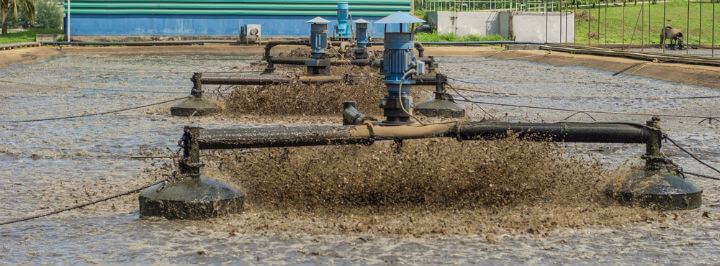How Does Activated Sludge Wastewater Treatment Work?
Written by AOS Treatment Solutions on May 15, 2018

The activated sludge wastewater treatment process is widely used and relied on by many municipalities. This process utilizes a multi-chamber reactor unit that uses microorganisms as a method to remove nutrients from the water. Oxygen is used to establish and regulate aerobic conditions and to suspend the sludge. The activated sludge wastewater treatment provides many advantages, but it may not be appropriate in all situations.
What Is Activated Sludge Wastewater Treatment?
The activated sludge process is an integral process used to treat wastewater. Air or oxygen is blown into raw sewage. It is most effective for large volumes of water. Wastewater is mixed and aerated in a special tank. This step in the process occurs by pumping air or oxygen into the activated sludge tank or using surface aerators. The process oxidizes organic matters in the wastewater, producing new cells, carbon dioxide, and water. The sludge particles can then be removed through the process of gravity settling.
Activated sludge sewage treatment is ideally completed in a centralized treatment facility. The treatment of activated sludge can occur in most climates. However, colder environments reduce the treatment capacity.
AOS professionals can discuss activated sludge treatment methods and other wastewater treatment services during a thorough consultation.
How Does the Activated Sludge Process Work?
The activated sludge process in the treatment of wastewater involves blowing oxygen or air into raw, unsettled sewage. This process smashes the solids. The sewage is bubbled, and sewage liquor is discharged into an activated sludge chamber. Live bacteria settle to the bottom of the tank and dead bacteria float to the top. Clean water is discharged into a soakaway or watercourse while the live bacteria return to the digestion chamber.
It is important to understand what activated sludge is to comprehend how the complete activated sludge system works. The sludge is considered activated because the particles are actively swarming with beneficial bacteria that digest the sewage.

Advantages of the Activated Sludge Treatment Process
The activated sludge treatment process provides many significant advantages over other options. Sewage treatment plants that primarily use the process for the treatment of activated sludge offer the following advantages:
- The amount of undesired sludge is reduced.
- The sewage treatment plants re-seed themselves with beneficial bacteria.
- The activated sludge treatment process allows the emptying intervals to be longer.
- The process is very reliable.
- The process is more simple.
- Costs are reduced.
- The process can be odorless.
The activated sludge treatment process is one of the water treatment services that AOS has provided for decades. Our professionals can discuss if this method is appropriate, as well as other services that we provide.
Disadvantages of the Activated Sludge Treatment Process
The activated sludge treatment process does have some drawbacks and may not be appropriate for all applications. Some disadvantages associated with activated sludge include:
- There are initial high capital and operating costs that may deter some facilities from utilizing this method.
- Experts are required to design and construct the activated sludge system.
- Skilled personnel must operate and maintain the treatment of activated sludge.
- Electricity must be continuously used, increasing wastewater treatment energy consumption.
- Parts and materials may not be available on a local level.
- Sludge and effluent might require further treatment or appropriate discharge.
The activated sludge treatment process can provide an effective method to treat wastewater. Contact AOS today to discuss whether activated sludge is a process that is appropriate for you.

